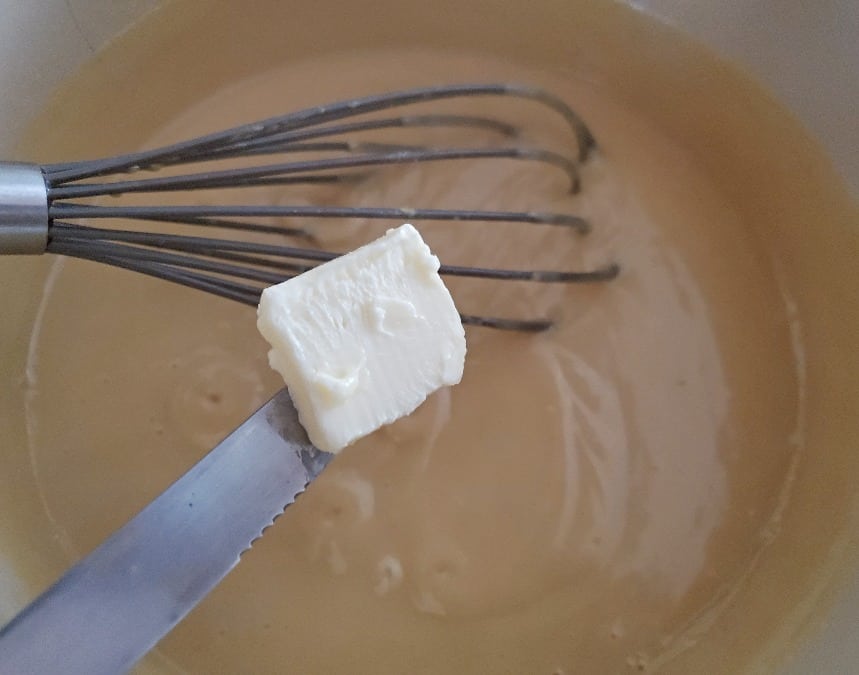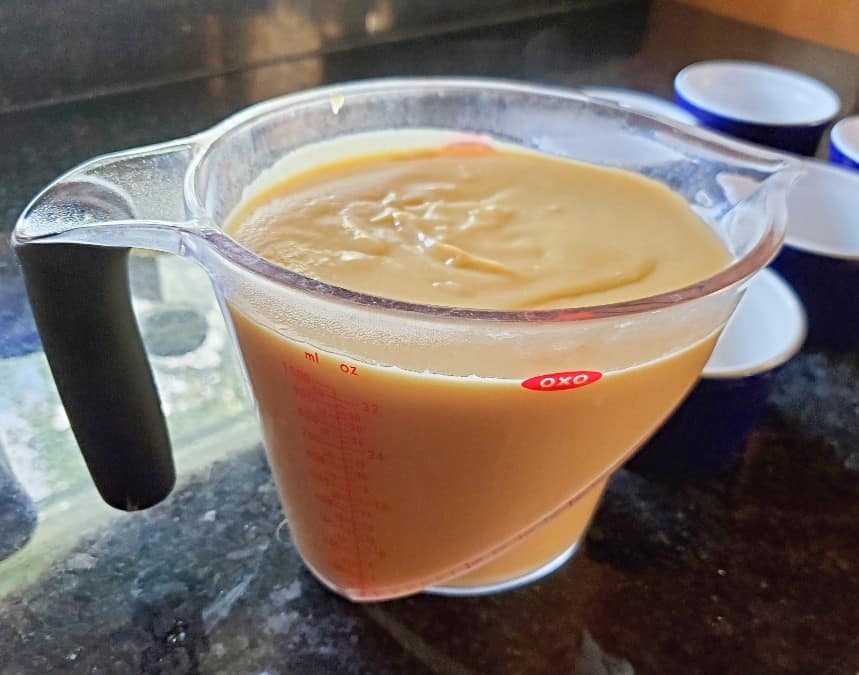This simple recipe for homemade butterscotch pudding is a keeper. No question.

Some links in this article are affiliate links that earn me a commission if you purchase through them.
Growing up, my mom made pudding from a box. I thought that’s what pudding tasted like.
Or what pudding should taste like?
Whichever.
Then I had a friend’s grandmother’s pudding, and my world changed. The difference between box pudding and homemade pudding is night and day.
I wish I had gotten her recipe that day, but silly me. In the years since, however, I’ve made pudding and custard regularly.
While I love chocolate pudding, a good homemade butterscotch pudding just transports me to childhood and my gram feeding me Werther’s candies. It is comfort food in a bowl.

When it’s been awhile since I last made pudding, I forget how quick and easy it is to make. This no bake dessert is quick to throw together; it’s just the chilling that requires patience.
And yes, I’ll admit that I usually save some of the pudding to eat still warm while I wait for the rest to finish.
Butterscotch pudding is a fantastic dessert all year round. It’s cool, which makes it great for hot weather, but it’s also so comforting that I’ll eat it in the dead of winter, too.
And all those pudding snacks and pudding cups? I might even feed this to my kids for snacks after school or special lunches, too. About the only thing I don’t do is mix it into my coffee….

Do I need to use whole milk to make butterscotch pudding?
Thankfully for my waistline, no. This recipe works with whole milk down to skim milk, although I do recommend using 2% milk if you can.
With lower fat milk, the pudding is less rich and creamy, but it still tastes good and has a beautiful consistency. In fact, if you use whole milk, you can actually reduce or even leave out the butter, as it doesn’t need that extra richness.
That said, don’t use buttermilk (you don’t want a sour tang) or evaporated milk, etc. This recipe is designed to use milk you drink, not specialty milk.
Should I use salted or unsalted butter for this pudding?
Always use unsalted butter unless a recipe specifies salted butter. With unsalted butter, you control how much butter gets added.
Different brands of butter add different amounts of salt, and it may be more or less than what you want in a recipe. When you add it yourself, you’re sure that you have exactly the amount of salt you expect.
Can I make dairy free butterscotch pudding?
Yes, yes you can. I have done it many many times before my daughter outgrew her dairy allergy. Depending on the kind of milk you use, it may have a slightly different taste, but it works.
Replace the milk with an equal amount of dairy free milk. Avoid the sweetened/vanilla flavored milk replacement, however.
I prefer to use rice milk because it adds the least amount of additional flavor, but you can use soy milk, coconut milk, oat milk, almond milk, etc.
For the butter, do the same one to one replacement. If you can do ghee, use that. If ghee is not an option, coconut oil works well, although it does add a slight flavor change.
My trick when using coconut oil? I weight it with a digital scale, as each tablespoon is a half ounce. That’s much easier than trying to measure it any other way.
Why do you put plastic wrap on pudding?
When milk cooks and then cools, it forms a skin where it touches air. The skin tends to be thick and somewhat rubbery.
No one wants to eat that.
If you place plastic wrap over your pudding and make sure there are no air pockets, the skin doesn’t form. It retains the perfect creamy pudding texture you want from top to bottom.
How to Make Homemade Butterscotch Pudding
In a heavy saucepan, add the egg yolks, brown sugar, salt, and cornstarch. Whisk them together until light and airy.
Add a half cup of milk and whisk again until it’s smooth. Adding the milk slowly helps to prevent lumps later in the process.
Pro tip: Make sure your milk is cold, and don’t turn on the heat yet.
Once the mixture is smooth, add the remaining milk. Continue to whisk until it’s incorporated, which is pretty quick.
Turn your stove to medium heat, and cook your butterscotch pudding until it starts to simmer. Continue whisking occasionally.
Once the mixture starts to simmer, turn the heat to low. If you let it boil, the cornstarch will break down, and your pudding will not set up.
Whisk constantly at a simmer for two minutes until it thickens. Don’t go longer than three minutes though.
Remove your pot from the heat, and add your butter. Cut your butter into pieces rather than adding it in one chunk so that it melts faster.

Add the vanilla, and whisk to until the butter is fully melted and incorporated into the butterscotch pudding.
Add the pudding to a four cup or larger liquid measuring cup. This makes it easier to pour into your dishes without spilling or burning yourself.

Pour into your dishes or ramekins. Feel free to fill them as much or as little as you like.
Place pieces of plastic wrap over the dishes, and chill in the refrigerator for at least four hours or overnight.

Serve cold alone or topped with whipped cream or berries.
Try one of these other fun custards and puddings next time!
- Mango custard
- Chocolate pudding
- Vanilla pudding
- Apple pie bread pudding
- Cinnamon roll bread pudding
- Cherry Bavarian custard
Classic Butterscotch Pudding
Ingredients
- 6 egg yolks
- 1 1/4 cups brown sugar
- 1/2 teaspoon salt
- 3 tablespoons cornstarch
- 3 cups milk
- 3 tablespoons unsalted butter
- 1 1/2 teaspoons vanilla
Instructions
- Add egg yolks, brown sugar, salt, and cornstarch to a large heavy pot. Whisk until light and airy.6 egg yolks, 1 1/4 cups brown sugar, 1/2 teaspoon salt, 3 tablespoons cornstarch
- Add a half cup milk and whisk until smooth, then add the remaining milk and whisk again.3 cups milk
- Turn heat to medium and bring to a simmer. Once it simmers, turn the heat to low and whisk constantly for two minutes.
- Remove from heat, and add butter and vanilla. Whisk until the butter is melted and completely incorporated.3 tablespoons unsalted butter, 1 1/2 teaspoons vanilla
- Pour pudding into a 4 cup measuring cup, then carefully pour into dishes.
- Place plastic wrap atop each pudding cup, and press gently to remove any air bubbles.
- Refrigerate for at least 4 hours, then serve cold.
Video
Notes
- If you add just a bit of the milk to the sugar and eggs to start, it helps prevent lumps as you finish the recipe. If you forget and add all the milk at once, don’t stress.
- Cut the butter into smaller pieces rather than putting it into the pudding. This helps it melt faster and makes whisking much easier.
- For more tips and tricks, be sure to read the full article above.
Nutrition
This site uses an online source to provide nutrition estimates as a courtesy. If you need exact values, please calculate yourself.

I am a participant in the Amazon Services LLC Associates Program, an affiliate advertising program designed to provide a means for sites to earn advertising fees by advertising and linking to Amazon.com.



You didn’t even list vanilla in the ingredients
It’s in there 🙂 You need 1 1/2 teaspoons vanilla for this. Let me know if you have any other questions.